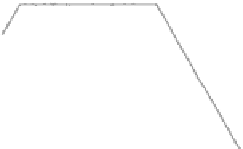Environmental Engineering Reference
In-Depth Information
Fig. 7.42 a Stack voltage
and current acquisition versus
time during the dynamic cycle
characterized by the maxi-
mum stack current variation
of 2 A/s. Air management
strategy N.4. b Stoichiometric
ratio and air flow rate acqui-
sition versus time for the
experiment (a). c Stack tem-
perature (measured at the
outlet of cathode side), water
temperature (measured in the
cooling circuit at the outlet of
the stack), inlet air relative
humidity and temperature
acquisition versus time for the
experiment (a)
a
80
250
Stack Voltage
75
200
Stack Current
70
150
65
60
100
55
50
50
45
0
0
50
100
150
200
250
Time [s]
b
5
30
4
25
3
20
2
15
1
Stoichiometric Ratio
Air Flow Rate
10
0
0
50
100
150
200
250
Time [s]
c
320
100
315
99
310
98
305
97
300
Humidity
Air Temp. OUT Stack [K]
Air Temp. IN Stack [K]
H2O Temp [K]
96
295
290
95
0
50
100
150
200
250
Time [s]
with the same thermal management of Fig.
7.43
c. In addition, also the voltage
profile results affected by the faster dynamic, as stack voltage reaches lower values
(47 V) for about 10 s just after the acceleration phase (Fig.
7.44
a).
A further indication of the effect of the load variation rate on the stack working
regularity is obtained by the calculation of C
v
values, carried out on the base of the
acquisition versus time of the individual cell voltages. The C
v
profile referred to














































































































































































































































































